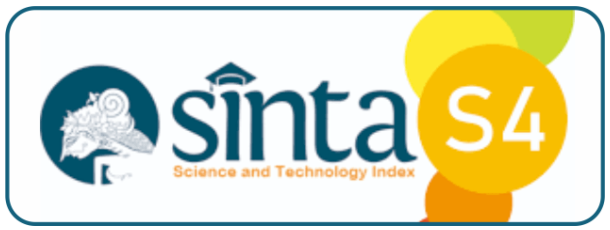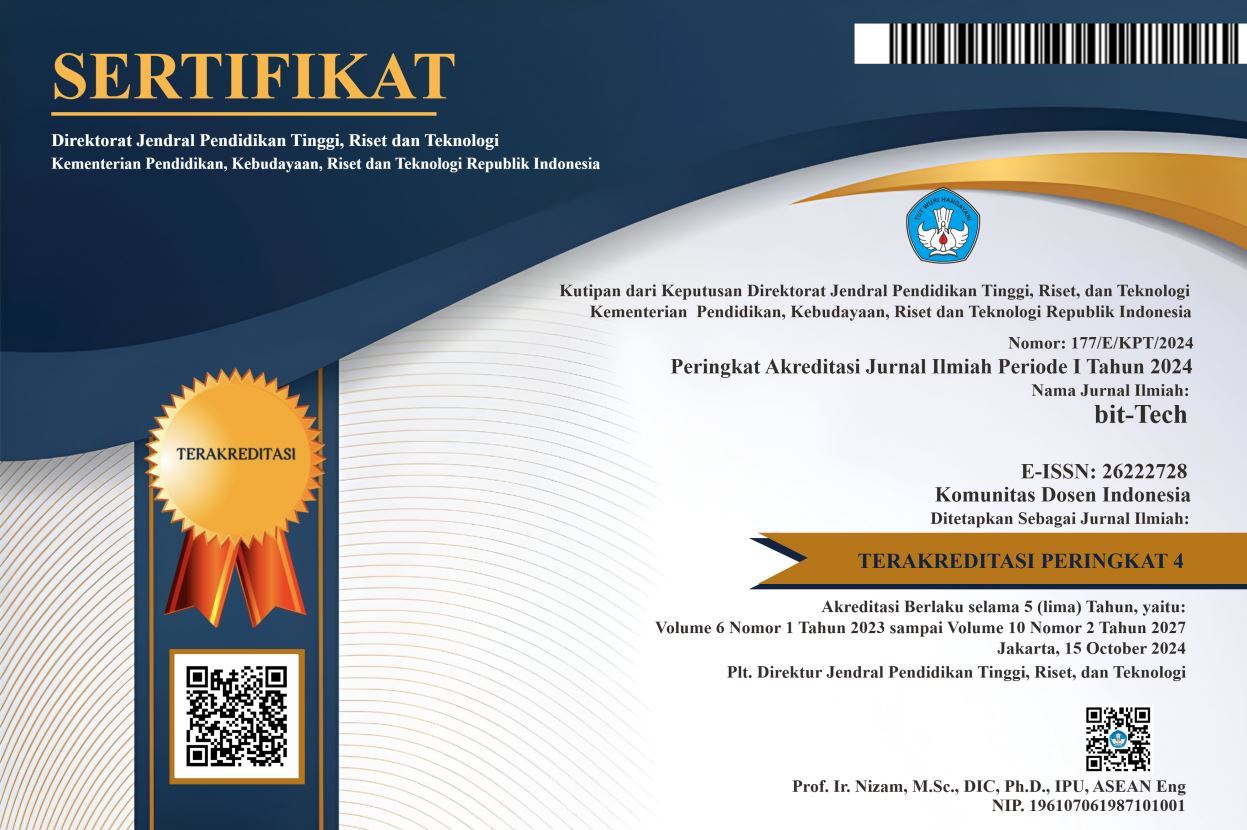Boarding House Provider Information with Multi Attribute Utility Theory (MAUT) Method
DOI:
https://doi.org/10.32877/bt.v5i3.729
Keywords:
Boarding House, Multi Attribute Utility Theory, Perceived Ease of Use, Perceived Usefulness, Technology Acceptance Model
Abstract
The increasing rate of population growth in urban areas to find work or study and the high Basic Credit Interest Rates for Home Ownership Loans, the choice of renting a boarding house can be an alternative for those who do not want to stay in the long term. Implementation of Decision Support System provide choices for information system in order to assist the community in choosing a place to live such as a boarding house. One method of Decision Support System is Multi Attribute Utility Theory (MAUT). MAUT can be interpreted as method of systematic comparison by finding the total weight of a set of values in the criteria to obtain results. MAUT method on a web-based information system, it can help people determine the choice of the desired boarding house. The results from the MAUT method will be used an objective consideration for users. The results of this study were tested by Technology Acceptance Model to measure the acceptance of systems. The calculation of TAM uses questionnaire distributed to 88 respondents and based on t-statistics on the TAM test, Perceived Ease of Use (PEOU) against Attitude Toward Using (ATU) is 2.660, Perceived Usefulness (PU) against ATU is 4.218. Then Behavior Intention to Use (BITU) for Actual System Use (ASU) is 16,122 and PU for BITU is 4,218. Where the indicator to have a positive influence when the value is above 1.9894. Meanwhile, ATU against BITU is only 1.179 which means that it does not have a positive influence.
Downloads
References
BPS, “Penduduk, Laju Pertumbuhan Penduduk, Distribusi Persentase Penduduk Kepadatan Penduduk, Rasio Jenis Kelamin Penduduk Menurut Provinsi/Kabupaten/Kota 2018-2020,” Badan Pusat Statistik, 2021. https://karanganyarkab.bps.go.id/statictable/2021/06/07/313/laju-pertumbuhan-penduduk-per-tahun-distribusi-persentase-penduduk-dan-rasio-jenis-kelamin-penduduk-menurut-kecamatan-di-kabupaten-karanganyar-2020.html%0Ahttps://jakarta.bps.go.id/indicator/12/1.
BTN, “Suku Bunga Dasar Kredit,” btn.co.id, 2021. .
N. Purwati and N. Anggreani, “Perancangan Sistem Informasi Penerimaan Jasa Servis Pada CV. Java Multimedia Yogyakarta,” Indones. J. Softw. Eng., vol. 6, no. 1, pp. 33–43, 2020, doi: 10.31294/ijse.v6i1.8042.
H. A. Septilia and S. Styawati, “Sistem Pendukung Keputusan Pemberian Dana Bantuan Menggunakan Metode AHP,” J. Teknol. dan Sist. Inf., vol. 1, no. 2, pp. 34–41, 2020.
B. Nadeak, “The Effectiveness of Distance Learning Using Social Media during the Pandemic Period of COVID-19: A Case in Universitas Kristen Indonesia,” Int. J. Adv. Sci. Technol., vol. 29, no. 7, pp. 1764–1772, 2020.
T. Wiendhyra, N. H. Harani, and R. Habibi, Sistem Informasi Manajemen Aset Sekolah Menggunakan Metode Multi Attribute Utility Theory. Kreatif, 2019.
R. N. Sari and R. S. Hayati, “Penerapan Metode Multi Attribute Utility Theory (MAUT) Dalam Pemilihan Rumah Kost,” J-SAKTI (Jurnal Sains Komput. dan Inform., vol. 3, no. 2, p. 243, 2019, doi: 10.30645/j-sakti.v3i2.144.
A. I. Abdurrahman, B. Yuwono, and Y. Fauziah, “Penerapan Metode Multi Attribute Utility Theory (Maut) Dalam Pemetaan Tingkat Dampak Bencana Banjir Di Kabupaten Bantul,” Telematika, vol. 17, no. 1, p. 26, 2020, doi: 10.31315/telematika.v17i1.3402.
M. L. O. Mardin, A. Fuad, and H. K. Sirajuddin, “Sistem Pendukung Keputusan Pemilihan Perumahan Dengan Menggunakan Metode Multi Attribute Utility Theory,” J. Ilm. Ilk. - Ilmu Komput. Inform., vol. 4, no. 2, Jul. 2021, doi: 10.47324/ilkominfo.v4i2.129.
N. Safitri and R. Pramudita, “Copyright@2018. P2M STMIK BINA INSANI Pengujian Black Box Menggunakan Metode Cause Effect Relationship Testing,” Inf. Syst. Educ. Prof., vol. 3, no. 1, pp. 101–110, 2018.
V. Dutot, V. Bhatiasevi, and N. Bellallahom, “Applying the technology acceptance model in a three-countries study of smartwatch adoption,” J. High Technol. Manag. Res., vol. 30, no. 1, pp. 1–14, 2019, doi: 10.1016/j.hitech.2019.02.001.
A. S. Rosa and M. Shahaludin, Rekayasa Perangkat Lunak: Terstruktur dan Berorientasi objek. Penerbit Informatika Bandung, 2016.
R. Diogenes Susilo, B. Daniawan, and A. Wijaya, “The Acceptance Study of e-commerce Customers Based on TAM,” Bit-Tech, vol. 3, no. 3, 2021.
F. S. Rahayu, D. Budiyanto, and D. Palyama, “ANALISIS PENERIMAAN E-LEARNING MENGGUNAKAN TECHNOLOGY ACCEPTANCE MODEL (TAM) (STUDI KASUS: UNIVERSITAS ATMA JAYA YOGYAKARTA),” J. Terap. Teknol. Inf., vol. 1, no. 2, pp. 87–98, Nov. 2017, doi: 10.21460/jutei.2017.12.20.
M. R. Julianto and B. Daniawan, “E-COMMERCE INFORMATION SYSTEM USING TECHNOLOGY ACCEPTANCE MODEL APPROACH,” Technol. Accept. Model. J. TAM, vol. 13, no. 1, 2022.
R. N. M. N. Rahmawati, “Actual Usage Use of E-Learning With Technology Acceptance Model (TAM),” J. Inov. Teknol. Pendidik., vol. 6, no. 2, pp. 127–136, 2019.
K. Ardianto and N. Azizah, “Analisis Minat Penggunaan Dompet Digital Dengan Pendekatan Technology Acceptance Model (TAM) Pada Pengguna di Kota Surabaya,” J. Pengemb. Wiraswasta, vol. 23, no. 1, p. 13, 2021, doi: 10.33370/jpw.v23i1.511.
N. Latifah, S. Rokhmawanto, P. Purwanto, and L. Syarifah, “Penerimaan mahasiswa terhadap pembelajaran daring selama pandemi Covid-19 dengan pendekatan Technology Acceptance Model,” J. Inov. Teknol. Pendidik., vol. 8, no. 2, pp. 151–162, 2021, doi: 10.21831/jitp.v8i2.39755.
R. Sholihah and A. D. Indriyati, “Analisis Kepuasan Pengguna Aplikasi Camscanner Menggunakan Metode Technology Acceptance Model (TAM) dan End-User Computing Satisfaction (EUCS),” J. Emerg. Inf. Syst. Bus. Intell., vol. 3, no. 3, pp. 102–109, 2022.
W. Astuti and B. Prijanto, “Faktor yang Memengaruhi Minat Muzaki dalam Membayar Zakat Melalui Kitabisa.com: Pendekatan Technology Acceptance Model dan Theory of Planned Behavior,” Al-Muzara’Ah, vol. 9, no. 1, pp. 21–44, 2021, doi: 10.29244/jam.9.1.21-44.
V. R. RADITYA, “Analisis Penggunaan Teknologi Aplikasi Akuntansi Pada Usaha Kecil Dan Menengah (UKM) Di Kabupaten Banyumas Melalui Pendekatan Technology Acceptance …,” J. Ris. Akunt. Soedirman, vol. 1, no. 1, 2020.
M. M. Alamri et al., “Towards adaptive e-learning among university students: By applying technology acceptance model (TAM),” Int. J. Eng. Adv. Technol., vol. 8, no. 6 Special Issue 3, pp. 270–276, 2019, doi: 10.35940/ijeat.F1043.0986S319.
A. Mayjeksen and D. Pibriana, “Technology Acceptance Model (TAM) Untuk Menganalisis Penerimaan Pengguna Terhadap Penggunaan Aplikasi Belanja Online XYZ,” J. Tek. Inform. dan Sist. Inf., vol. 7, no. 3, pp. 580–592, Dec. 2020.
H. P. Dewi and Z. Meutia, IMPLEMENTASI TQM PADA LEMBAGA PENDIDIKAN (STUDI KASUS YPIM MIFTAHUSSALAM MEDAN). Cattleya Darmaya Fortuna, 2022.
Downloads
Published
How to Cite
Issue
Section
License
Copyright (c) 2023 bit-Tech

This work is licensed under a Creative Commons Attribution-ShareAlike 4.0 International License.
I hereby assign and transfer to bit-Tech all exclusive copyright ownership rights to the above work. This includes, but is not limited to, the right to publish, republish, downgrade, distribute, transmit, sell, or use the work and other related materials worldwide, in whole, or in part, in all languages, in electronic, printed, or any other form of media, now known or hereafter developed and reserves the right to permit or license a third party to do any of the above. I understand that this exclusive right will belong to bit-Tech from the date the article is accepted for publication. I also understand that bit-Tech, as the copyright owner, has sole authority to license and permit reproduction of the article. I understand that, except for copyright, any other proprietary rights associated with the work (e.g. patents or other rights to any process or procedure) must be retained by the author. In addition, I understand that bit-Tech permits authors to use their papers in any way permitted by the applied Creative Commons license.


 DOI :
DOI :
 Abstract views: 369
/
Abstract views: 369
/  PDF downloads: 313
PDF downloads: 313











